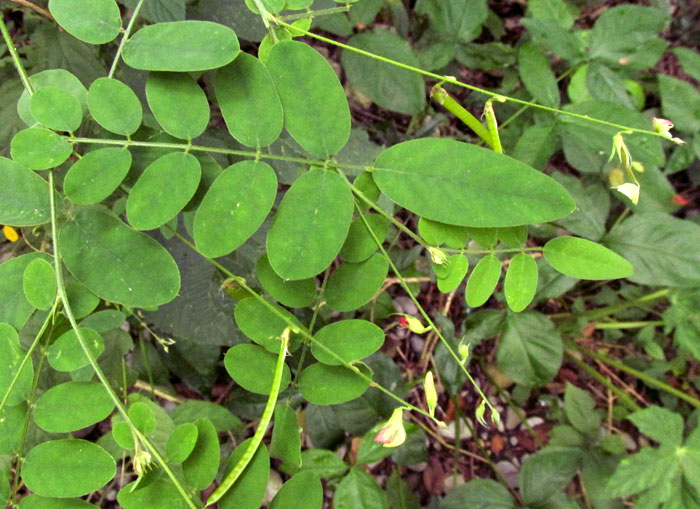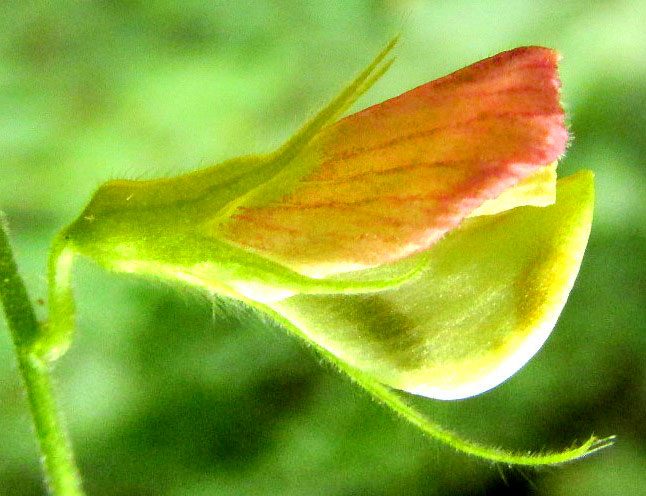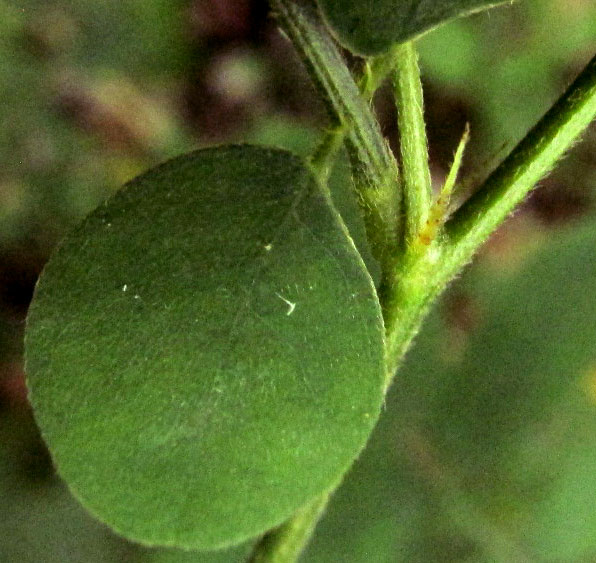Excerpts from Jim Conrad's
Naturalist Newsletter
entry from field notes dated October 9, 2022, taken about 3kms north of Gómez Farías, bushes along eroded gravel road descending toward Cañón el Azteca, Aztec Canyon, on the lower eastern slope of the Eastern Sierra Madres, El Cielo Biosphere Reserve, southern Tamaulipas state, MÉXICO; elevation about 300m (1000 ft), ± LAT. 23.04°N, LONG. 99.15°W
ANIL FALSO

The above sprawling, weed-entangled, tough-stemmed "subshrub" appeared at the edge of a wall of weeds, bushes and small trees along the gravel road to Cañón el Azteca. With its pinnately compound leaves, legume-type fruits and flowers of the kind seen on a garden bean vine, the plant shows typical features of the big Bean Family. The only somewhat unusual feature for the Bean Family to be seen in the above picture is the long flower cluster with its blossoms and legumes distantly spaced on slender but stiff, straight rachis.

The above papilionaceous flower is typical for the Bean Family's subfamily faboideae, and tribe Robinieae, reflecting its close relationship with North America's locust trees. Note the rose-colored veins ornamenting the flower's top petal, the pale side petals, or wings, almost hidden beneath the top petal, and at the bottom, the two fused lower petals forming a yellowish, scoop-shaped keel. Those features and the long, narrow lower calyx lobe are all fine field marks, plus note how the flower's short stem, or pedicel, is thickened at its base, crooks, and narrows toward the flower. Despite all these distinctive features, when I tried to identify this plant, the flowers made it hard.

However, the slender, narrow fruit was just right for what the plant seemed to be.

Above, you can see that the plant's vegetative parts are generally short-hairy. The stipules are unusually slender, sharp and somewhat stiff.
The above features led fairly directly to COURSETIA CARIBAEA, in English publications fairly consistently referred to as Anil Falso, or "False Anil." The name Anil is a corruption of the Spanish Añil, with a tilda, or ~, over the n, and regarded as a completely different word from anil. Añil is the name for a pasty, dark-blue dye, indigo dye, formerly derived from various species of the Bean Family genus Indigofera -- before synthetic dyes took over -- and those Indigofera species producing the dye often are referred to by the name of añil. In fact, those dye-producing Indigofera species are somewhat similar in appearance to our False Anil.
Matt Lavin in his excellent 1988 publication "Systematics of Coursetia (Leguminosae-Papilionoideae)" wrote, "The eight varieties of C. caribaea with a total of 23 synonyms attest to the morphological variability of this species." He points out that field and greenhouse studies indicate that differences in "calyx lobe size, herbage and floral vestitures, leaf morphology, degree of woodiness, and the presence of tuberous roots" are continuously variable characters. With regard to the flower in our picture, he also remarks that ".. flower size and color are occasionally invariable in certain geographical regions and may occur in distinctive combinations."
Thing is, in this part of southern Tamaulipas state, the literature indicates the presence only of the variety C. caribaea var. caribaea, and while the Flora del Bajío describes the flowers as bearing white, rose-colored or yellow flowers, and the top petal as varying from 5-12mm long, the vast majority of pictures of C. caribaea var. caribaea on the Internet show blossoms on which the top not only is pure white but also much larger than ours. Our flower with its short, rosy top petal looks very like the variety C. caribaea var. sericea, but that variety seems to be restricted to more arid northwestern Mexico and Arizona in the US.
Whatever the variety or locally restricted "distinct combination" of flower size and color, it seems clear that our plant is some form of Coursetia caribaea, which commonly occurs from the southwestern US and the Caribbean area south into northern South America, and here and there farther south.
Sometimes in Mexico our plant is called jícama de conejo, or "rabbit jícama," jícama being a vine member of the Bean Family famous in much of the world's tropics for producing large, very edible tuberous roots. In English sometimes jícama is called Mexican Turnip. Our "rabbit jícama" produces small, elongated tuberous thickenings, which certain wildlife might relish.